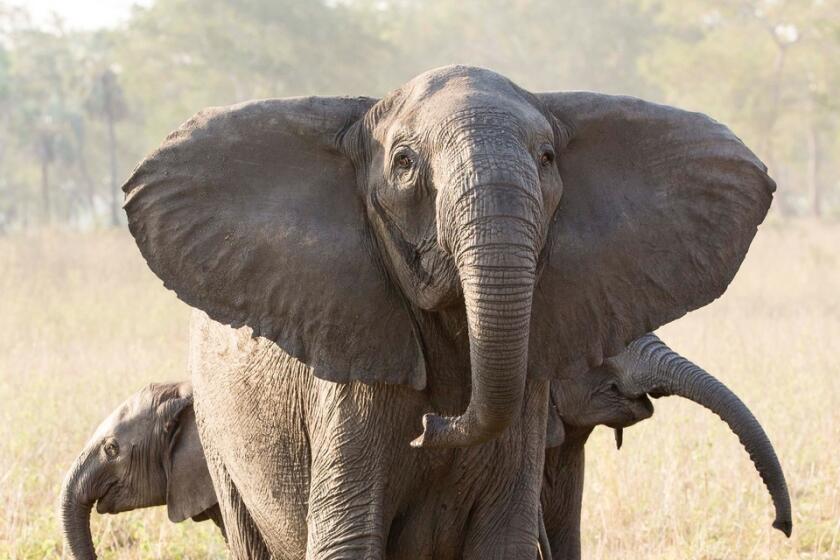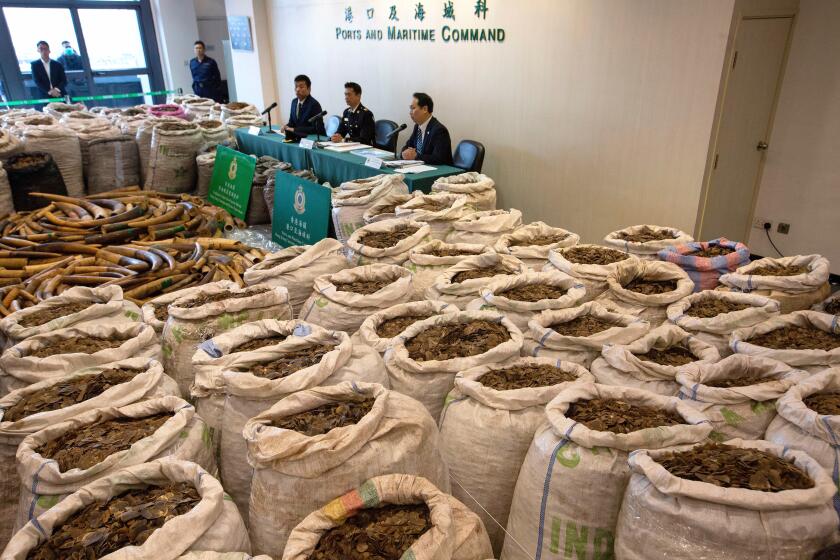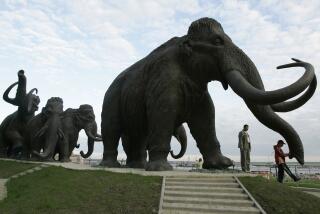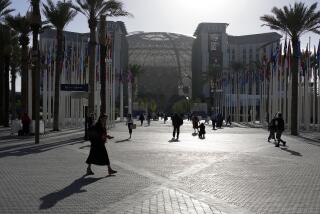Iconic African wildlife to be the focus at world conference
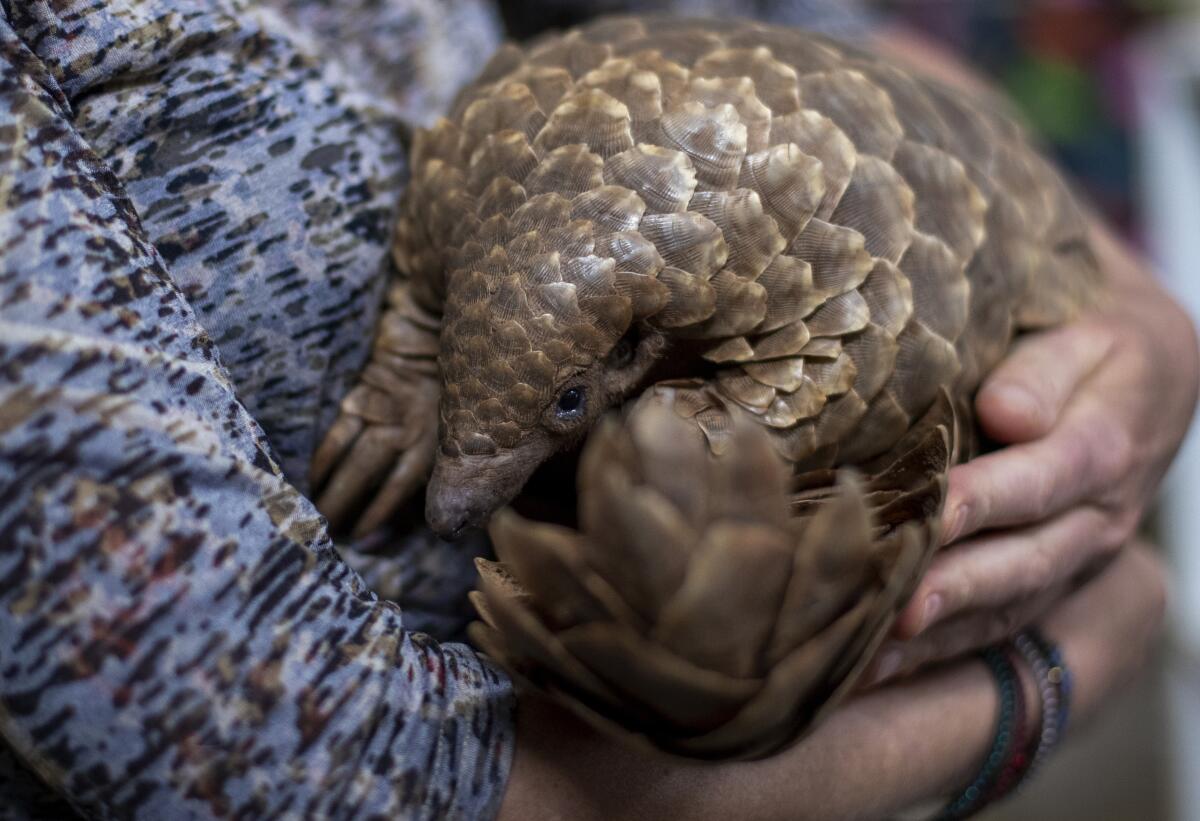
- Share via
MOMBASA, Kenya — Iconic African wildlife such as elephants, big cats and rosewood trees will be central to discussions of the World Wildlife Conference slated for Panama later this year.
The standing committee meeting of the U.N. wildlife trade body, called the Convention on International Trade in Endangered Species, which met last week in Lyon, France, slated these animals and trees for the main agenda of discussion during the Panama wildlife conference, scheduled for November.
The wildlife body is the highest decision-making organ on global wildlife trade. It is expected to make decisions on the resolutions set in Lyon on flagship wildlife including pangolins, West African vultures, parrots, orchids, seahorses, marine turtles, Malagasy ebonies, sharks and rays.
“African nations are providing a strong example to the world of how states can collaboratively take action against illegal international trade in wildlife,” said Ivonne Higuero, secretary-general of the Convention on the International Trade in Endangered Species of Wild Fauna and Flora (known as CITES). ”In Central and West Africa, there is a new political commitment and engagement to combat the illegal trade of endangered species of wild animals and plants.”
Higuero added that African countries had led by example in instituting the African Carnivore Initiative, which aims to conserve lions, leopards, cheetahs and the African wild dog species.
The U.N. wildlife agency makes three distinctions for listing of wildlife according to the degree of protection needed. It also spells out commercial rules covering over 38,000 species of plants and animals, requiring member states to penalize any violation of the procedures that it sets. Each October since 2017, member states have been required to submit data on all seizures of wildlife made in the previous year. Nearly 6,000 species have been seized between 1999-2018, ranging from mammals, reptiles, coral, birds and fish according to the U.N. crime office records.
The World Wildlife Seizures Database, which is a global repository of reported wildlife confiscations compiled by the UN office on drugs and crime, is the main tool used to review worldwide illegal commercial trends. Between 1999 and 2018, there were more than 180,000 seizures, covering 6,000 species spread across 149 countries represents the network of illegal wildlife trade, according to the database.
Scientists have pinpointed how years of civil war and poaching in Mozambique have led to a greater proportion of elephants that will never develop tusks.
Poaching and trafficking records indicate that ivory trade saw a resurgence around 2007 and grew steadily until around 2011, before declining in 2016. The estimated number of elephants in African countries in 2006 was 556,973. This number has decreased to the current 413,242.
Trends of wildlife trophy seizures accumulated in the last four years reveal that there has been a shift in ivory shipments, with Lagos Port in Nigeria dominating exports and Vietnam as the main elephant tusks importer. Previously, the Mombasa Port in Kenya held the primacy of illicit ivory shipments and China took the lead as the main importer.
U.N. records also indicate that the “largest flow of illicitly harvested rosewood in the past four years is coming out of Africa.” Global imports of tropical hardwood logs totaled 18 million cubic meters in 2018, valued at more than $3 billion. Some 82% of the value of this import demand came from industries based in China, which leads the world in furniture manufacturing.
California may soon pass a law to ban the import of “trophy” animal parts from Africa. Activists are targeting an L.A. hunter whose hunt was captured on video.
Up until 2013, one of the more prominent non-Asian sources for rosewood was Madagascar, where at least 48 species are known to occur, with 47 of them being widespread on the Indian Ocean island nation. A recommendation to suspend trade in species of rosewood from Madagascar was made in 2016 and remains in place to this day.
“The rosewood crisis has been devastating West African forests and the livelihoods of its people for almost a decade,” said Raphael Edou, the Africa program manager of the environmental group.
The U.S., China, Vietnam, the United Arab Emirates, the European Union, Japan and Malaysia remain the main destinations of trafficked rosewood, accounting for three-quarters of all logs seized globally.
Instead of protecting confiscated pangolins -- already critically endangered -- a local government body is accused of sending them back to smugglers.
Pangolins in Africa are increasingly being hunted for their meat and their scales. The bulk of pangolin exports comes from Nigeria, Guinea, Liberia, Cameroon, Central African Republic, Congo and Gabon. According to the wildlife database, Uganda, the Democratic Republic of Congo, Burundi and Congo-Brazzaville are hubs and logistics nodes of pangolins’ transshipment in Africa, with China as the largest importer. In 2016 due to overexploitation of pangolins, the wildlife body placed a global trade ban on the animal.
While the Lyon standing committee highlighted the plight of Africa’s wildlife, decisions aimed at curbing illegal trade and the future of the continent’s iconic species will be decided by officials at the Panama conference.
More to Read
Sign up for Essential California
The most important California stories and recommendations in your inbox every morning.
You may occasionally receive promotional content from the Los Angeles Times.
